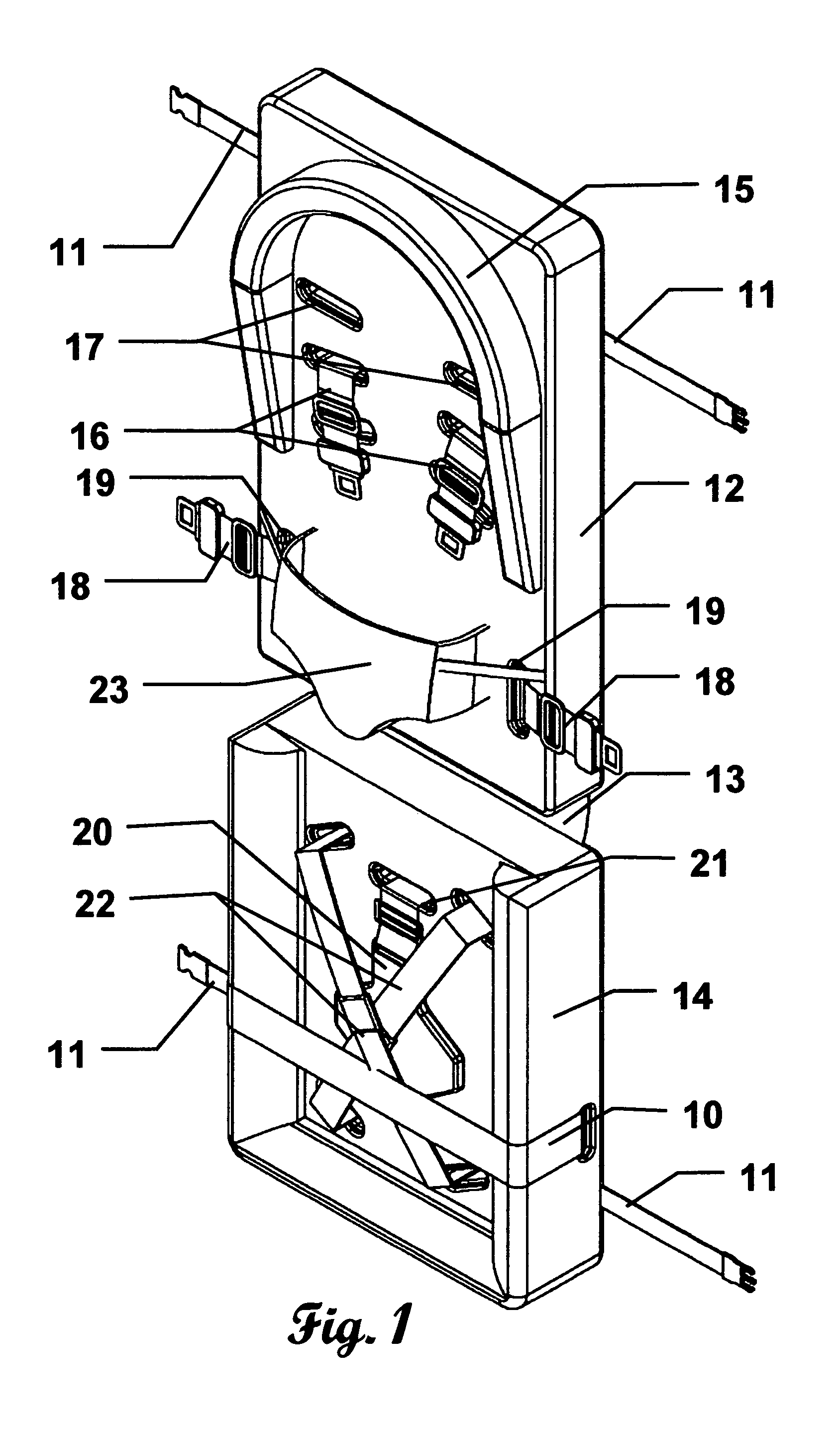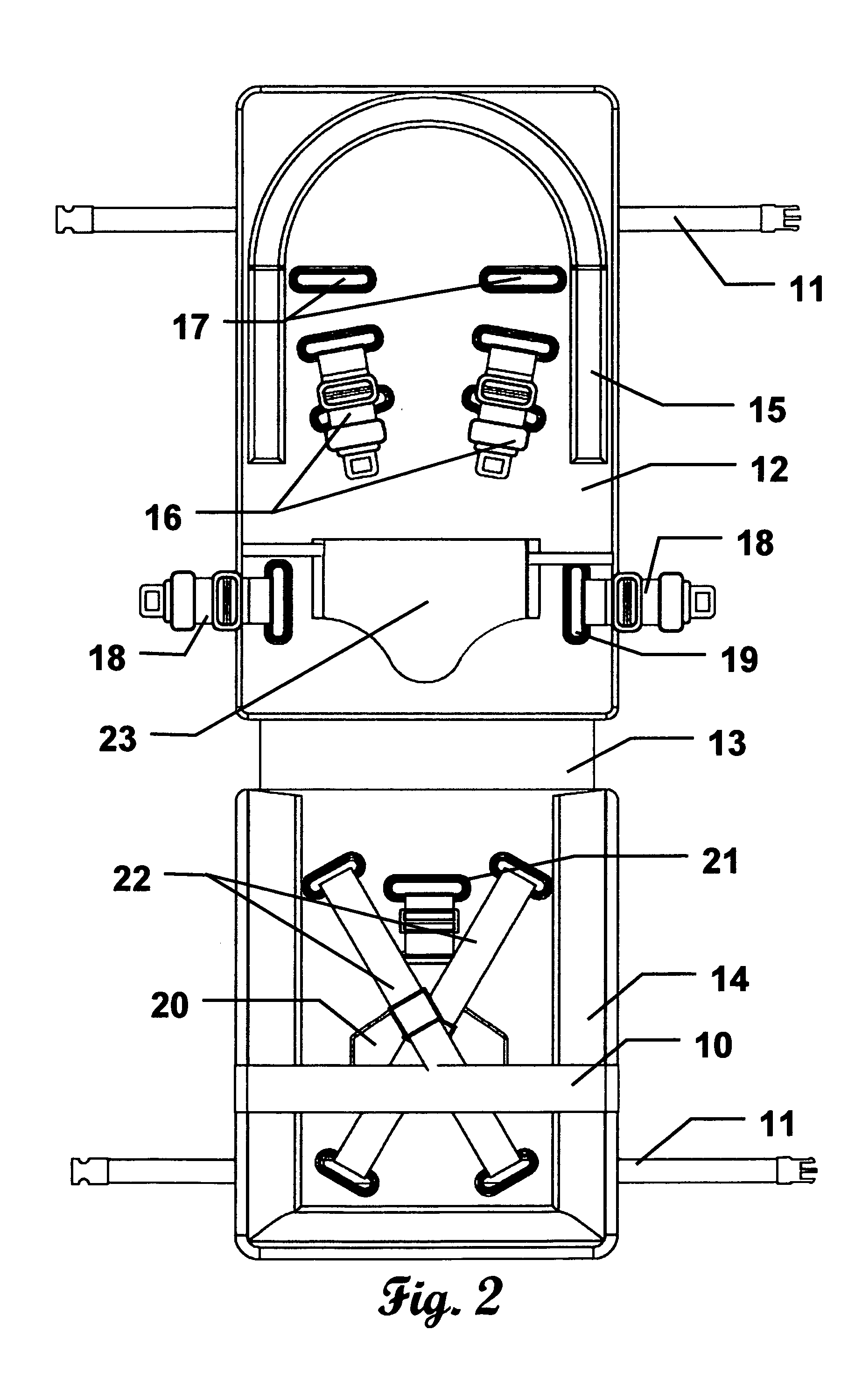The majority of these devices are large hard-shell construction and uncomfortable to transport.
Most parents complain and oppose to the weight of current seats that can only be considered transportable, not portable.
Additionally, current devices are not designed to safely restrain a child of any age and size.
No current restraint devices can both cradle an infant in a restrained reclined position and further restrain a child or toddler in an upright-seated position.
This use is limited to normally one or two children over the useful life of the restraint device.
As the restraint device is intended for long stable placements, relatively routine removal and replacement of the attached device in a passenger seat is generally a cumbersome process.
Current Federal
Aviation Administration (FAA) rules allow children under the age of two to be retained in parents' laps, which obviously provides little, if any, protection to the child during an accident or in an emergency situation.
Conventional restraint devices used for automobiles are inadequate for use with existing aircraft seats.
The main problem is the fact that the
anchor point for an automobile seat is located generally aft and below the point where the back and sitting portion of the frame members meet.
FAA's studies have shown that conventional car seats perform poorly in simulated aircraft accidents.
Conventional automotive seats may not meet these criteria when installed in aircraft seats.
Thus, if aircraft
seat belt is inserted through the slot in the back portion of the conventional restraint device a tight attachment of the device to the aircraft seat is not possible.
Thus, during an accident the loose attachment of a conventional car restraint device to an aircraft passenger seat would cause the restraint device to rotate or travel forward, via rotational or translational forces acting on the aircraft passenger seat.
This
scenario could possibly cause the child or infant disposed therein to hit his or her head against the food tray or seat disposed in the row in front of the infant or child.
Accordingly, conventional restraint devices cannot be sufficiently anchored to prevent a child's head from striking the seat ahead.
As such, too much forward or rotational movement is allowed.
Additional problems with the use of conventional restraint devices are that modern automobile restraints use a short fixed-length strap on one side.
Airplane passenger seat belts are manually adjusted, and the range of adjustment is limited.
Another problem is that the available lateral space for the installation of a child restraint device on
airplane seats is limited to the distance between the arm rests.
However, seats in some rows have non-stowable arm rests.
The FAA Report found that conventional forward facing restraint devices were unacceptably loose when attached to an
airplane passenger seat due to
vertical path of the lap belt securing the device to seat.
This loosely secured conventional child restraint device resulted in poor performance during testing and could cause serious injury in use.
The FAA report labeled the poor interface with
airplane lap belts which resulted in a very loose fit as a “misuse condition.”
The FAA Report also found conventional harnesses and backless booster seats to also be dangerous for
aviation use.
The harnesses also allowed too much room for movement.
It was found that due to the limited adjustment range and anchor location of the airplane seat lap belts, the harness restraint could not satisfactorily restrain the motion of a typical three year old child.
The loose tensions of the lap belts did not provide secure restraint utilizing the harness.
As the
child booster seat are backless, in a
crash a child could be crushed between the booster seat and the seat back.
The FAA Report also found that the booster seat could not be correctly installed in an airplane seat and that the child occupant could be exposed to potential abdominal injury due to the combined effects of forces imparted from the aft row occupant and the seat back breakover.
The FAA Report concluded that the performance of certain types of child restraint devices, currently available, do not enhance the level of safety for children in transport
airplane passenger seats and that the expectation of equivalent protection for children restrained in certain types of child restraint device traveling by automobile can not be met in an airplane seat.
One of the stated reasons for these negative results is that the restraint devices are designed to meet automotive requirements, which do not necessarily adapt properly to an airplane seat.
The lap belt
anchor point geometry on airplane seats does not afford effective restraint of forward excursion of the occupant with this type of child restraint.
These differences adversely affect the performance of child restraint devices designed primarily for the automobile interior.
Furthermore, any modification to any part of an aircraft requires extensive testing to be performed per strict
aviation regulations.
This is in addition to the cost and time which is involved for such testing and modifications of a new aircraft seat, as well as the time involved in obtaining governmental approval.
Thus, the possibility of changing the position of seat belts on existing airline passenger seats, to make use with car restraint devices safe, is not practical.
 Login to View More
Login to View More  Login to View More
Login to View More 


